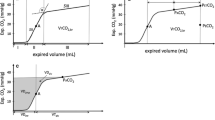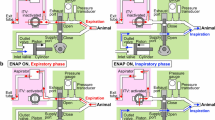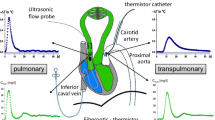Abstract
Effects of general (G) versus selective (S) right (R) and left (L) positive end-expiratory pressure (PEEP) were compared during differential lung ventilation in 11 anaesthetized dogs in the supine position. GPEEP 20 cm H2O decreased cardiac output (1 min−1) from 2.9±0.2 (mean±SE) to 1.7±0.5 (p<0.05), RPEEP from 2.8±0.2 to 2.2±0.2 (p<0.05) while LPEEP caused no significant change in cardiac output. GPEEP increased pleural pressure more than SPEEP. Pleural pressure was asymmetric during SPEEP. Both SPEEP and GPEEP increased pericardial pressure uniformly, but the increase was less marked with SPEEP. During GPEEP 20 cm H2O transmural left ventricular end-diastolic pressure (LVEDP) decreased markedly. SPEEP caused less marked reductions in transmural LVEDP. Qualitatively similar, but less marked changes were observed with PEEP 10 cm H2O. In conclusion, cardiac output decreased less with selective PEEP than with general PEEP. This was explained by less increase in pleural and pericardial pressure, and accordingly less decrease in LV transmural filling pressure.
Similar content being viewed by others
References
Fermoso JD, Richardson TQ, Guyton AC (1964) Mechanism of decreased cardiac output caused by opening the chest. Am J Physiol 207:1112–1116
Cournand A, Motley HL, Werko L, Richards DW (1948) Physiologic studies of the effect of internittet positive pressure breathing on cardiac output in man. Am J Physiol 125:162–174
Quist J, Pontoppidan H, Wilson RS, Lowenstein E, Laver MB (1975) Hemodynamic responses to mechanical ventilation with PEEP: the effect of hypervolemia. Anesthesiology 42:45–55
Rankin JC, Olsen CO, Arentzen CE, Tyson GS, Maier G, Smith PK, Hammon JW, Davis JW, McFlale PA, Anderson RW, Sabiston DC (1983) The effects of airway pressure on cardiac function in intact dogs and man. Circulation 66:108–120
Culver BH, Marini JJ, Butler J (1981) Lung volume and pleural pressure effects on ventricular function. J Appl Physill 50:630–635
Marini JJ, Culver BH, Butler J (1981) Mechanical effect of lung distention with positive pressure on cardiac function. Am Rev Respir Dis 124:382–386
Marini JJ, Culver BH, Butler J (1981) Effect of positive end-expiratory pressure on canine ventricular function curves. J Appl Physiol 51:1367–1374
Kingma I, Smiseth OA, Frais MA, Smith ER, Tyberg JV (1987) Left ventricular external constraint: relationship between pericardial, pleural and esophageal pressures during positive end-expiratory pressure and volume loading in dogs. Ann Biomed Eng 15:331–346
Cassidy SS, Ramanathan M (1984) Dimensional analysis of the left ventricle during PEEP: relative septal and lateral wall displacements. Am J Physiol 246:H792-H805
Jardin F, Farcot JC, Boisante L, Curien N, Margairaz A, Bourdarias JP (1981) Influence of positive end-expiratory pressure onleft ventricular performance. N Engl J Med 304:387–392
Klingstedt C, Baehrendtz S, Bindeslev L, Hedenstierna G (1985) Lung and chest wall mechanics during differential ventilation with selective PEEP. Acta Anaesthesiol Scand 29:716–721
Baehrentz S, Santesson J, Bindeslev L, Hedenstierna G, Matell G (1983) Differential ventilation in acute bilateral lung disease. Influence on gas exchange and central haemodynamics. Acta Anaesthesiol Scand 27:270–277
Hedenstierna G, Baehrentz S, Klingstedt C, Santesson J, Søderborg B, Dahlborn M, Bindeslev L (1984) Ventilation and perfusion of each lung during differential ventilation with selective PEER. Anesthesiology 61:369–376
Hedenstierna G, Santesson J, Baehrentz S (1984) Variations or regional lung function in acute respiratory failure and during anaesthesia. Intensive Care Med 10:169–177
Hotvedt R, Platou ES, Koppang ER, Refsum H (1982) Pentobarbital plasma concentrations and cardiac electrophysiology during prolonged pentobarbital infusion anesthesia in the dog. Acta Anaesthesiol Scand 26:638–642
Jansen JRC, Versprille A (1986) Improvement of cardiac output estimation by the thermodilution method during mechanical ventilation. Intensive Care Med 12:71–79
Smiseth OA, Frais MA, Kingma I, Smith ER, Tyberg JV (1985) Assessment of pericardial constraint in dogs. Circulation 71:158–164
Smiseth OA, Scott-Douglas NW, Thompson CR, Smith ER, Tyberg JV (1987) Non-uniformity of pericardial surface pressure in dogs. Circulation 75:1229–1236
Smiseth OA, Scott-Douglas NW, Traboulsi D, Stone JA, Smith ER, Tyberg JV (1987) The role of the pericardium: experimental aspects. Heart Failure: 36–12
McMahon SM, Permutt S, Proctor DF (1969) A model to evaluate pleural surface pressure devices. J Appl Physiol 27:886–891
Author information
Authors and Affiliations
Rights and permissions
About this article
Cite this article
Veddeng, O.J., Hysing, E.S. & Smiseth, O.A. Selective positive end-expiratory pressure and cardiac function in dogs. Intensive Care Med 16, 298–302 (1990). https://doi.org/10.1007/BF01706353
Received:
Accepted:
Issue Date:
DOI: https://doi.org/10.1007/BF01706353




